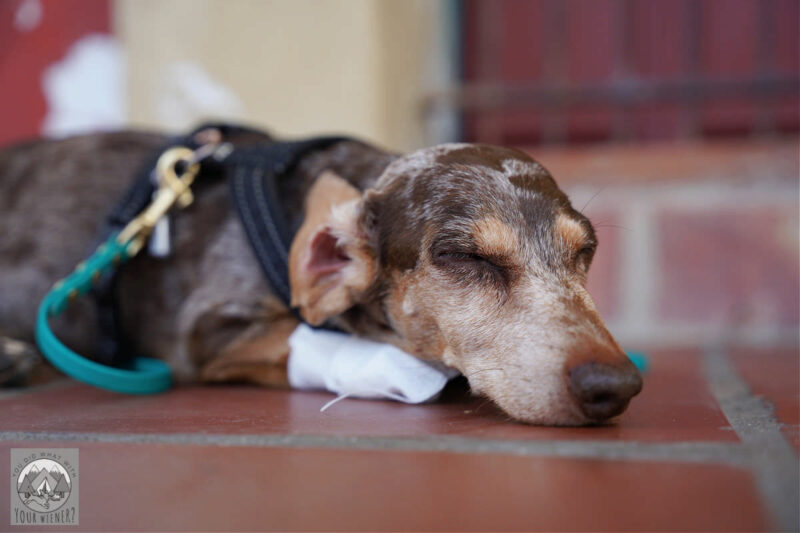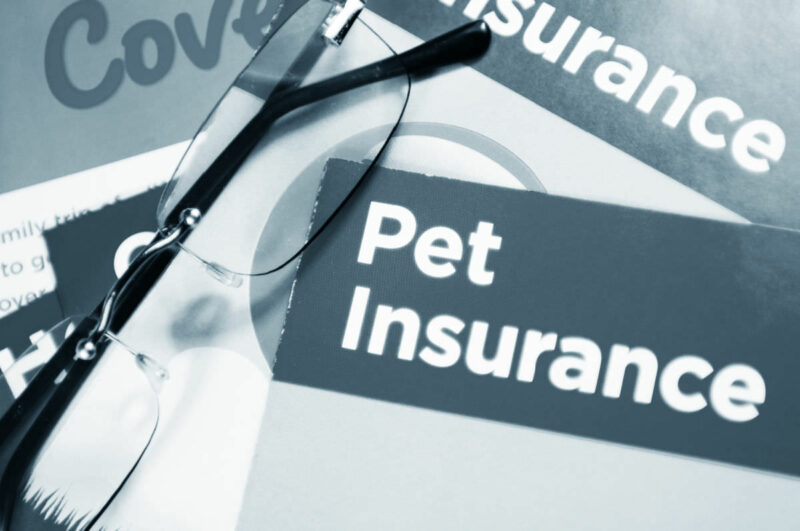Best Pet Insurance for Dachshunds
I frequently get asked what I think the best pet insurance for Dachshunds is.
We’ve had pet insurance for over 10 years, and I have used it for three different Dachshunds.
I love the fact that I can freely make medical decisions based on what is best for my dog and not money.
Pet insurance certainly is not cheap though.
In this article, I discuss what pet insurance covers and what it doesn’t, provide a comparison chart for the top 12 pet insurance companies, and help you decide if pet insurance is worth it for you.

What is Pet Insurance?
Pet insurance is a type of insurance policy designed to help pet owners cover the cost of veterinary care for their pets.
Just like health insurance for humans, pet insurance provides financial protection and peace of mind in case your Dachshund gets sick or injured.
Pet owners pay a monthly or annual premium to the insurance company for “coverage”.
When a Dachshund owner takes their dog to the vet, the insurance policy may reimburse the owner for part of the bill.
This portion paid by the insurance company is calculated based on:
- Whether the specific illness, injury, test, or treatment is eligible for coverage.
- The deductible: the amount you must pay out of pocket before the insurance coverage kicks in.
- The co-pay: the percentage of the covered costs you are responsible for; what is left after the reimbursement percentage is paid.
Note: not all procedures, treatments, and tests are covered so sometimes the insurance company won’t pay out at all for that visit.
What Does Pet Insurance Cover?
While what pet insurance companies will and won’t cover can vary, they typically cover:
- Injuries/accidents- broken bones, cuts, ingestion of foreign objects, etc.
- Illnesses/infections – anal gland ruptures, ear infections, seizure disorders, cancer, chronic conditions, etc.
- Medically necessary dental procedures – extraction of rotten or broken teeth, removal of retained baby (deciduous) teeth, oral fistula repair, etc.
- Medications prescribed by a veterinarian.
- Emergency care – emergency room visits or after-hours care.
- Specialist care – specialists like neurologists, surgeons, internal medicine doctors, or dermatologists.
Some additional things may be covered with a policy upgrade or insurance rider. In other words, if you pay more.
Examples of what might be covered by a supplemental policy include:
- Wellness care – vaccinations, check-ups, and preventive treatments like flea and tick control.
- Alternative therapies – hydrotherapy, cold laser, physical therapy, acupuncture, etc.
- Routine dental cleaning.
- Spay and neuter procedures.
- Behavioral therapy – In some cases, coverage for behavioral training or therapy might be included.
Except in rare instances, an owner will pay the bill in full and then submit a claim to their pet insurance company.
The company will review the claim and determine what portion of the bill they are responsible for, if any, and will reimburse the owner for that amount via check or direct deposit.
Overview: Pet Insurance Differences & Similarities
I spent months researching and comparing different pet insurance companies from the perspective of a Dachshund owner.
The result of this research is summarized in the pet insurance comparison chart below.
However, among the sea of potentially overwhelming information, some patterns emerged.
What most pet insurance companies have in common:
- You pay monthly for a policy.
- You can adjust the deductible, reimbursement percentage, or maximum payout, or sometimes 2-3 of these, to change the monthly fee a little.
- They all have some kind of waiting period after enrollment before they will cover accident and/or illness claims.
- All pet insurance policies in the comparison chart cover intervertebral disk disease (IVDD), congenital and hereditary conditions.
- No insurance policy covers preexisting conditions (however, some do cover “curable conditions” as long as it’s been 6+ months since symptoms or treatment).
Note: curable conditions generally mean a medical condition or injury that can be completely resolved without recurrence, or showing any clinical signs, is considered a curable medical condition.
- All companies will raise your rate as the years go on (based on age, rising vet costs in your area, or both).
- Almost all companies offer some kind of nominal discount for eligible customers.
This means that the things above are unlikely to play a significant role in your choice in pet insurance company.
So, what will?

Deciding factors in choosing pet insurance: the differences
What makes a pet insurance company stand out?
What are the key things to look for that will likely influence your decision?
Here are the major differences between pet insurance companies:
- Cost per month – this can vary significantly.
- Reimbursement percentage – most allow you to choose your reimbursement rate by 10% – 30%, which affects your monthly premium but can also make a substantial difference when the bill is high.
- Some insurance companies don’t have a maximum annual or lifetime payout but several do. The payout limit for some is what the typical IVDD surgery will cost.
- Some companies offer an insurance rider, which will allow coverage of some wellness, preventative, routine dental cleaning, and spay/neuter procedures.
- While all have certain requirements that must be met first, three companies will sometimes pay a veterinarian directly, so you don’t have to front the money and wait to be reimbursed.
- One company – Wagmo – will only pay out up to $100,000 in a Dachshund’s lifetime (others may have an annual limit but not lifetime).
These are the things you will want to think about most when evaluating a pet insurance company and comparing them to others.
What to Look for When Choosing Pet Insurance for Your Dachshund
I think the most compelling reason to get pet insurance for your Dachshund is to cover the cost of back surgery if it’s ever needed.
Since most Dachshund back problems are caused by a genetic disease (intervertebral disk disease- IVDD), you will want to choose an insurance company that covers “congenital and “hereditary” (fancy words for “genetic”) conditions.
Spinal surgery for IVDD-related disk ruptures in Dachshunds will typically cost $8,000 – $10,000, so it’s also important to pay attention to the annual maximum payout.
One back surgery can exhaust your available reimbursement allowance for the year and it’s not unheard of for a Dachshund to need a second surgery within 12 months.
Also note that it’s typically advised to follow up surgery with treatments such as hydrotherapy, cold laser, acupuncture, and physical therapy.
For this reason, it’s not a bad idea to choose a policy that already includes coverage for those things, or purchase the “extras” plan, if you can afford it.
Pet Insurance Comparison Chart
Disclosure: Many of the links on this pate are affiliate links (Amazon Associate or other programs we participate in). As an affiliate, I earn a small commission from qualifying purchases.
If you want to get into the nitty-gritty details of the top 13 different pet insurance companies, I created this pet insurance comparison chart below for you.
All cost quotes are for a 3-year-old, male, neutered miniature Dachshund living in Seattle, WA (zip code 98103).
The chart below will give you a thorough overview but do keep in mind that things change frequently in the insurance word.
Always verify the information is correct for your company of choice.
Note: The research for this chart was completed in 2023. Use the scroll bar at the bottom of the chart to view the entire L-R chart.
For a Google Sheets version of the chart with a few more details, including the different deductible and reimbursement options, and which might be easier to view, click HERE.
| Insurance | Cost Per Month | Deductible | Reimbursement | Max Payout | Enrollment Age | Accident/Illness Waiting Period | Cover IVDD, Congenital & Hereditary Conditions? | Wellness & Preventative Care Covered? | Teeth Cleaning Covered? | Spay & Neuter Paid or Discount? | Pay Vet Directly? | Cover Pre-existing conditions? | Cost Increases Due to … | Discounts | Notes |
|---|---|---|---|---|---|---|---|---|---|---|---|---|---|---|---|
| Pet’s Best | $41.26 | $250* | 80%* | Unlimited* | 7 weeks – no max | 3 days/14 days** | Yes | Yes, with policy ad-on | Yes, with policy ad-on | Yes, with policy ad-on | No | No | Age | 5% military | None |
| Trupanion (& State Farm) | $121.67 | $250* | 90% | Unlimited | birth – 13 years | 5 days/30 days | Yes | Not available | No | No | Yes*** | No | Increasing vet costs in your area | None | lifetime per condition deductible |
| Healthy Paws | $82.26 | $250* | 80%* | Unlimited | 8 weeks – 14 years | 15 days/15 days** | Yes (prior to 6 y.o. for hip dysplasia) | Not available | No | No | No **** | No | Age | 5% for select memberships & organizations | Refer-a-Friend program donates $25 to shelters for each referral |
| Wagmo | $46.97 | $250* | 90%* | $20,000 | “as soon as you bring your dog home” – no max | 15 days/15 days** | Yes | Yes, with policy ad-on | Yes, with policy ad-on | No | No | No | Age; Increasing vet costs in your area | Up to 10% multi-pet, 15% claims free at renewal | Lifetime payout of $100,000 per pet |
| Lemonade | $31.58 | $250* | 80%* | $100,000* | 8 weeks – 14 years | 2 days/14 days** | Yes | Yes, with policy ad-on | Yes, with policy ad-on | Yes, with policy ad-on | No | No | Age | 10% bundle discount, 5% multi-pet discount, 5% annual discount | None |
| Embrace | $92.14 | $250* | 80%* | Unlimited* | 6 weeks – 14 years | 48 hours/14 days** | Yes | Yes, with policy ad-on | Yes, with policy ad-on | Yes, with policy ad-on | No | “Curable” conditions can be covered if pet is symptom & treatment free for 12 months | Age; Increasing vet costs in your area | 10% multi-pet discount, 5% military discount | None |
| Figo | $66.24 | $250* | 80% | Unlimited* | 8 weeks – no max | 1 day/14 day** | Yes | Yes, with policy ad-on | Yes, with policy ad-on | Yes, with policy ad-on | No | “Curable” conditions can be covered if pet is symptom & treatment free for 12 months | Age | 5% multi-pet discount | None |
| Nationwide | $63.92 | $250* | 70%* | $10,000 | Min not stated – 10 years (major medical plan) | 14 days/14 days** | Yes | Yes, with policy ad-on | Yes, with policy ad-on | Yes, with policy ad-on | No | “Curable” conditions can be covered if pet is symptom & treatment free for 6 months | Age; Increasing vet costs in your area | 5-10% multi-pet discount, depending on the number of pets, 5% discount for Nationwide members | Quote reflects standard Whole Pet plan, but there is also a Major Medical plan where covereage is set for each medical condition individually |
| Pumpkin | $82.35 | $250 | 90% | Unlimited* | no age limits | 14 days/14 days** | Yes | Yes, with policy ad-on | No | No | No | “Curable conditions” can be covered if the pet is symptom & treatment free for 180 days | Rates are “subject to change at renewal” | 10% multi pet discount | None |
| Fetch (by Dodo – formerly PetPlan) | $79.27 | $300* | 80%* | $15,000* | no age limit | 15 days/15 days** | Yes | Not available | No | No | No | No | Age | 15% Healthy Pet Credit for claims free | None |
| Spot | $71.37 | $250* | 80%* | Unlimited* | 8 weeks – no max | 14 days/14 days** | Yes | Yes, with policy ad-on | Yes, with policy ad-on | Yes, with policy ad-on | Yes, with vet initiated claims | “Curable conditions” can be covered if the pet is symptom & treatment free for 180 days (except for knee & ligament conditions) | Age | 10% multi-pet discount | None |
| Met Life | $36.38 | $250* | 80%* | $10,000* | no age limit | 0 days/14 days** | Yes | Yes, with policy ad-on | No | No | No | No | Age | 10% discount for vets, shelter personnel and other animal care professionals, 10% discount for military, veterans, 1st responders, healthcare workers, $1/month Internet Purchase Discount | Family plan allows coverage for multiple pets on a single policy |
| ASPCA | $49.83 | $250* | 80%* | $10,000* | no age limit | 14 days/14 days** | Yes | Not available | No | No | No | “Curable conditions” can be covered if the pet is symptom & treatment free for 180 days | Age | 10% multi-pet discount | None |
What Pet Insurance to I Have for My Dachshunds?
As I said in the introduction, both of my Dachshunds are covered by Trupanion insurance.
I really like it because:
- I find the claims process to be easy
- It has a fair reimbursement policy (I believe this despite complaints I see from time to time – which often boil down to not reading the fine print and incorrect expectations)
- I am typically reimbursed within 3 days of claim approval.
- I love that there is the potential to pay the vet directly, so I don’t have to come up with a bunch of cash for a large bill (I’ve never tried this option though).
My experience
When my first Dachshund Chester was a senior, he needed several procedures, including bowel obstruction surgery.
The total bill was around $8,000.
I don’t remember the exact amount, but I did the math at the time and it “paid me back” for all of the monthly premiums I had paid for two dogs over the previous 7 year period!
Trupanion is one of the most expensive insurance policies though, especially if you purchase the rider to cover alternative therapies.
What I pay
My monthly cost for Trupanion insurance is $173.29.
Here are the basic details of our policies:
- One miniature Dachshund, 13.5 years old, female, spayed: base policy only
- One miniature Dachshund, 5 year old, female, female, intact (ovary sparying spay): base policy plus the Recovery and Complementary Care (alternative therapies) rider
- Living in a rural area outside of Seattle, (the monthly cost was $50 more when we lived in Seattle – a big city).
- Deductible per incident: $400
- Reimbursement rate: 90%
When I get a third Dachshund, I will absolutely get pet insurance again.
Will I get Trupanion for my next Dachshund?
I’m not sure I will go with Trupanion again when I add another Dachshund.
My total premium for 3 would be around $260 and that is out of my budget or, at the very least, a huge stretch.
When we first joined Trupanion 12 years ago, you could adjust your deductible up and down at any time, thus adjusting your monthly premium.
Now, while you can still adjust your deducible, you can only increase it. There’s no opportunity to go back, and that feels a little scary for me.
On one hand, I am afraid to stray from Trupanion because I trust them but, on the other, I would like to have experience with a different company.
If I didn’t go with Trupanion, I would likely try Pet’s Best or Figo as coverage is similar to Trupanion, the monthly premium has the potential to be half of what I am paying now, and I’ve heard good things about them.
I know that Trupanion will reimburse me within days though, if they don’t pay the vet directly to begin with.
However, I just found out that Pet’s Best can take around 4-6 weeks to reimburse (although a few have received payments within days).
It will be important for me to recoup my money as soon as possible after I pay the bill.
If I do stay with Trupanion, I will have to raise my deductible to somewhere between $500-$800 for each dog to make it more affordable for me.
Is It Worth Getting Pet Insurance?
Some people think that pet insurance is a waste of money.
Let’s take a closer look at the math.
If you purchased pet insurance
The average cost of pet insurance for an adult Dachshund about $72.10 a month, or $865.20 a year.
Let’s say your Dachshund doesn’t have any significant medical needs, and you don’t file any insurance claims, for 5 years.
During that 5 year period, you would have paid $4,326 to the insurance company.
If you put that money into a savings account instead
For comparison, let’s say you don’t get pet insurance and put the same amount as an insurance premium in a savings account monthly.
At the end of 5 years, assuming you did not dip into this fund for anything, which is very tempting to do, you would have $4,326 in savings.
How insurance vs no insurance plays out
Now, let’s say your Dachshund needs back surgery at the end of the 5th year and the quote is on the low end – $8,000.
With Insurance, you would pay your deductible, and the percentage of the bill not covered by insurance, for the surgery.
If your deducible is $500 and insurance pays 80%, you will pay the entire bill but get reimbursed for approximately $6,000 of it.
Since you paid $4,326 in insurance premiums over the previous 5 year period, you come out ahead $1,674.
If you don’t have pet insurance, you will use your savings of $4,326 plus an additional $3,674.
None of this will come back to you so you are out a total of $8,000.
What if my Dachshund never needs back surgery?
Approximately 25% of Dachshunds will have a back issue in their lifetime. Not all of them will need surgery.
However, there are whole lot of other expensive Dachshund health issues like Cushing’s disease and bowel obstruction (which can cost around $4,000 each).
IVDD and back surgery is not the only expensive health issue you need to worry about with a Dachshund.
The thing with insurance is that it’s always a gamble – the insurance company counting on people paying for a policy but never needing it and you paying for a policy hoping that someday it will be worth it (although, you simultaneously hope that you never do).
If your Dachshund only needed one $8,000 procedure, or several small ones totaling that amount, in their lifetime, the “savings” with insurance would likely be minimal.
If you paid a higher premium than the average for a month, or the average premium for two dogs, but the total lifetime insurance-eligible procedures only totaled $8,000, you would break even or lose money since you would have paid over $8,000 in that 5 year period.
Are you a good saver?
The argument people use most often against getting pet insurance is that they will just put the money (insurance premium) in a savings account instead.
Above, I explained how that could play out, but the bottom line is that it’s a gamble – you could financially come out ahead or lose money.
But if you are not good at saving like me, the insurance can act as kind of a forced “emergency savings”.
Before I got insurance for my first Dachshund, I tried the savings route.
But I suck at saving and money management. I was never disciplined enough to put the full amount in savings and never touch it.
Honestly, half of the time I had no savings at all, which would have really put me in a financial bind had he needed an expensive life-saving procedure.
I may not even been able to afford it.
Since I never wanted to have to make split-second, life-and-death decision based on money alone, I chose to enroll him in pet insurance.

Is Pet Insurance Worth It for a Senior Dog?
Whether pet insurance is worth it for an old dog depends on the individual dog.
If your senior Dachshund already has a lot of pre-existing health conditions, especially if you feel like nothing else could go wrong, it’s probably not worth it since none of that will not be covered.
If your senior Dachshund is very healthy with no known issues, it might be a good idea to get pet insurance.
The chance that senior dogs will develop something like cancer, mobility issues, digestive/nutrient absorption issues, or dementia is fair, so getting pet insurance in anticipation can help cover elder care costs.
But like with a Dachshund of any age, pet insurance is a bit of a gamble – you may never recoup your insurance premiums.
Is Pet Insurance Worth It for a Puppy?
The chance that a Dachshund puppy will need anything beyond routine care is not great. But it can happen!
I’ve heard stories of puppies that get parvo and about how the life-saving treatment for that can cost thousands of dollars.
My friend’s 6 month old puppy was acting strange – wouldn’t settle, constantly pacing and whining – and it turned out she had a liver shunt.
That life-saving surgery was thousands of dollars.
When my Dachshund summit was about 7 months old, she started having these phantom pains that would make her shriek.
Almost $2,000 worth of tests later, the vet couldn’t find anything wrong and it went away on its own.
Besides surprise medical costs for a puppy, no insurance will cover pre-existing conditions, so you need to get insurance for your puppy well before anything actually goes wrong.
So, to the question, “Should I get pet insurance for my puppy?” I say that is the perfect time to do it if you aren’t going to try the savings route instead.
Final Thoughts
Pet insurance can help pet owners manage unexpected and potentially costly veterinary bills.
It allows them to make decisions about their pet’s health based on what’s best for their Dachshund rather than on what they can afford.
However, it’s essential to carefully review policy details, including coverage, exclusions, and costs, to choose the right plan for your pet’s needs and your budget.
I hope that the information in this article helped you choose the right pet insurance for your Dachshund.


About the Author
Hi, I’m Jessica. I’ve been studying the Dachshund breed since 2007, owned 3 of my own, and shared in the lives of thousands of others through their owner’s stories. When I’m not sharing what I know on this blog, you can find me hiking, camping, and traveling with my adventurous wiener dogs.

What an amazing and helpful article. As a new puppy dachshund owner, insurance comparison was really needed. Thank you so much for your time and effort
Thanks for reading 🙂
We took our dachshund to the vet and they said he somehow injured his back. He is on crate rest and pain meds. The doc said he had 80% chance of full recovery – is it too late to get pet insurance? There is no diagnosis of IVD. Is this now a pre-existing condition?
I realize you are not an insurance expert, but just thought to ask.
I am so appreciative of your blog! Thank you for sharing your experience!
Hi Jennifer. No pet insurance will cover a back injury while it is active. Many will not even cover a second one, as “back issues” are considered an existing condition. However, there are a couple of insurance companies that will cover subsequent back issues if a certain amount of time has elapsed and it’s a different disk that has ruptured. You will likely have to call a representative directly to find out that information though.
How old is your Dachshund? Unless there is an acute injury from an obvious cause (like a large fall or car accident), Dachshund back injuries are almost 100% cased by IVDD, which is a genetic disease, especially if it occurs between the ages of 4 and 7 years. You might find it helpful to read this article about IVDD: https://youdidwhatwithyourweiner.com/the-truth-about-dachshunds-and-back-problems/
Good luck with recovery.